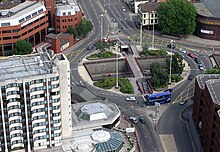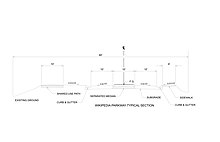
Civil engineering is a professional engineering discipline that deals with the design, construction, and maintenance of the physical and naturally built environment, including public works such as roads, bridges, canals, dams, airports, sewage systems, pipelines, structural components of buildings, and railways.
The vast majority of passenger travel in the United States occurs by automobile for shorter distances and airplane or railroad for longer distances. Most cargo in the U.S. is transported by, in descending order, railroad, truck, pipeline, or boat; air shipping is typically used only for perishables and premium express shipments. Transportation is the largest source of greenhouse gas emissions in the United States.

Transportation planning is the process of defining future policies, goals, investments, and spatial planning designs to prepare for future needs to move people and goods to destinations. As practiced today, it is a collaborative process that incorporates the input of many stakeholders including various government agencies, the public and private businesses. Transportation planners apply a multi-modal and/or comprehensive approach to analyzing the wide range of alternatives and impacts on the transportation system to influence beneficial outcomes.

Traffic engineering is a branch of civil engineering that uses engineering techniques to achieve the safe and efficient movement of people and goods on roadways. It focuses mainly on research for safe and efficient traffic flow, such as road geometry, sidewalks and crosswalks, cycling infrastructure, traffic signs, road surface markings and traffic lights. Traffic engineering deals with the functional part of transportation system, except the infrastructures provided.

Highway engineering is a professional engineering discipline branching from the civil engineering subdiscipline of transportation engineering that involves the planning, design, construction, operation, and maintenance of roads, highways, streets, bridges, and tunnels to ensure safe and effective transportation of people and goods. Highway engineering became prominent towards the latter half of the 20th century after World War II. Standards of highway engineering are continuously being improved. Highway engineers must take into account future traffic flows, design of highway intersections/interchanges, geometric alignment and design, highway pavement materials and design, structural design of pavement thickness, and pavement maintenance.

The Georgia Department of Transportation (GDOT) is the organization in charge of developing and maintaining all state and federal roadways in the U.S. state of Georgia. In addition to highways, the department also has a limited role in developing public transportation and general aviation programs. GDOT is headquartered in downtown Atlanta and is part of the executive branch of state government.
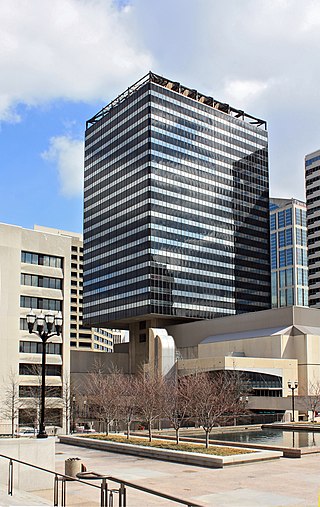
The Tennessee Department of Transportation (TDOT) is the department of transportation for the State of Tennessee, with multimodal responsibilities in roadways, aviation, public transit, waterways, and railroads. It was established in 1915 as the Tennessee Department of Highways and Public Works, and renamed the Tennessee Department of Transportation in 1972. The core agency mission of TDOT is to provide a safe and reliable transportation system for people, goods, and services that supports economic prosperity in Tennessee. Since 1998, TDOT has been ranked amongst the top five in the nation for quality highway infrastructure. It is primarily headquartered in downtown Nashville and operates four regional offices in Chattanooga, Jackson, Knoxville, and Nashville.
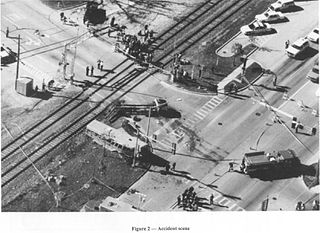
The 1995 Fox River Grove bus–train collision was a grade crossing collision that killed seven students riding aboard a school bus in Fox River Grove, Illinois, on the morning of October 25, 1995. The school bus, driven by a substitute driver, was stopped at a traffic light with the rearmost portion extending onto a portion of the railroad tracks when it was struck by a Metra Union Pacific Northwest Line train en route to Chicago.

Noise control or noise mitigation is a set of strategies to reduce noise pollution or to reduce the impact of that noise, whether outdoors or indoors.

The Texas Department of Transportation is a Texas state government agency responsible for construction and maintenance of the state's immense state highway system and the support of the state's maritime, aviation, rail, and public transportation systems. TxDOT previously administered vehicle registration prior to the creation of the Texas Department of Motor Vehicles in November 2009.
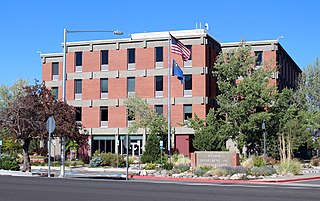
The Nevada Department of Transportation is a government agency in the U.S. state of Nevada. NDOT is responsible for maintaining and improving Nevada's highway system, which includes U.S. highways and Interstate highways within the state's boundaries. The department is notable for its aggressively proactive approach to highway maintenance. Nevada state roads and bridges have also been named some of the nation's best.

The Louisiana Department of Transportation and Development (DOTD) is a state government organization in the United States, in charge of maintaining public transportation, roadways, bridges, canals, select levees, floodplain management, port facilities, commercial vehicles, and aviation which includes 69 airports, in the U.S. state of Louisiana. The agency has approximately five thousand personnel on staff and an operating budget of $2.3 billion. DOTD operations are run through nine district offices across the state.

Land transport is the transport or movement of people, animals or goods from one location to another location on land. This is in contrast with other main types of transport such as maritime transport and aviation. The two main forms of land transport can be considered to be rail transport and road transport.
Pavement management is the process of planning the maintenance and repair of a network of roadways or other paved facilities in order to optimize pavement conditions over the entire network.

Traffic simulation or the simulation of transportation systems is the mathematical modeling of transportation systems through the application of computer software to better help plan, design, and operate transportation systems. Simulation of transportation systems started in the 1950s, and is an important area of discipline in traffic engineering and transportation planning today. Various national and local transportation agencies, academic institutions and consulting firms use simulation to aid in their management of transportation networks.
Geoprofessions is a term coined by the Geoprofessional Business Association to connote various technical disciplines that involve engineering, earth and environmental services applied to below-ground ("subsurface"), ground-surface, and ground-surface-connected conditions, structures, or formations. The principal disciplines include, as major categories:
Urban freight distribution is the system and process by which goods are collected, transported, and distributed within urban environments. The urban freight system can include seaports, airports, manufacturing facilities, and warehouse/distribution centers that are connected by a network of railroads, rail yards, pipelines, highways, and roadways that enable goods to get to their destinations.
In transportation engineering, the K factor is defined as the proportion of annual average daily traffic occurring in an hour. This factor is used for designing and analyzing the flow of traffic on highways. K factors must be calculated at a continuous count station, usually an "automatic traffic recorder", for a year before being determined. Usually this number is the proportion of "annual average daily traffic" (AADT) occurring at the 30th-highest hour of traffic density from the year's-worth of data. This 30th-highest hour of traffic is also known as "K30" or the "Design Hour Factor". This factor improves traffic forecasting, which in turn improves the ability of designers and engineers to plan for efficiency and serve the needs of this particular set of traffic. Such forecasting includes the selection of pavement and inclusion of different geometric aspects of highway design, as well as the effects of lane closures and necessity of traffic lights. Engineers have reached consensus on identify K30 as reaching a reasonable peak of activity before high outliers of traffic volume are used as determinative of overall patterns. The K factor has three general characteristics:
The Journal of Transportation Engineering, Part A: Systems is a peer-reviewed scientific journal published by the American Society of Civil Engineers. It covers planning, design, construction, operation, and maintenance of air, highway, rail, and urban transportation systems and infrastructure. Papers on road, bridge, and transit management; and transportation systems are encouraged, as well as those on connected and autonomous vehicles; highway engineering and economics, safety and environmental aspects of transportation.

On November 8, 2016, Illinois voters approved the Illinois Transportation Taxes and Fees Lockbox Amendment, a legislatively referred constitutional amendment that prohibits lawmakers from using transportation funds for anything other than their stated purpose.
